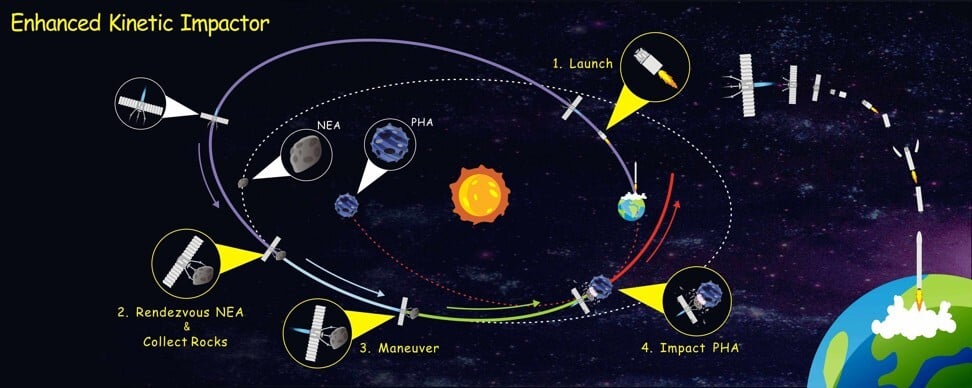
Crash course in saving the Earth: Chinese simulation stops asteroid strike without using nukes
- Computer model shows how potentially hazardous asteroids can be knocked off course and out of harm’s way using an ‘enhanced kinetic impactor’ spacecraft
- Nasa advocates the use of nuclear weapons to neutralise such threats, but the option is not without controversy
Chinese scientists have come up with an ingenious alternative to nuclear obliteration for neutralising the threat of potentially Earth-shattering asteroids – staging a cosmic collision to knock the offending rocky mass off course.
While Nasa has long advocated the use of nuclear weapons to neutralise the threat of so-called potentially hazardous asteroids, detonating a warhead in space is not without its problems or controversy.
The alternative, according to a team from the Chinese Academy of Sciences, is to send an unmanned spacecraft out to meet the incoming threat and deflect it out of harm’s way.
However, to have sufficient heft to do that, the spacecraft must first bulk up, which it does by collecting rocks from a near-Earth asteroid en route.
The team successfully tested their theory using a computer simulation, the results of which were published in a recent edition of the peer-reviewed online journal Scientific Reports.
Bad weather delays SpaceX and Nasa’s historic crewed launch
With the extra weight on board, EKI sets its sights on Apophis – a real asteroid with a diameter of about 370 metres (1,214 feet) that is considered one of the most potentially hazardous to human life – and on September 23, 2025 slams into it a relative speed of more than 42,000km/h (26,000mph).
The force of the collision is enough to push Apophis more than 1,800km (1,118 miles) off course – which in the simulation would have ended with a direct hit on Planet Earth – and the world is saved.
A Beijing-based space scientist who was not involved in the simulation and asked not to be named praised the EKI project for its “smart strategy of turning one asteroid against another”.
Not even the world’s most powerful rocket could send a 200-tonne spacecraft into deep space, he said, adding that the EKI and nuclear options were as different as tai chi and boxing.
“It [EKI] is more about trapping, slipping and deflecting the attack than throwing punches,” he said.
However, despite the mission’s simulated success, the actual technology needed to grab and secure rocks of up to 10 metres (33 feet) across from a passing asteroid had yet to be tested in the real world, he said.
The right stuff: SpaceX’s first astronaut launch has cool factor
Professor Wu Yunzhao, a researcher in the laboratory of planetary sciences at the Purple Mountain Observatory in Nanjing, said that while China was ready to play a key role in dealing with global threats like asteroid strikes, the issue demanded international cooperation.
“The threat of an asteroid impact is real and serious, and preventing it requires long-term planning and preparation,” he said.
“It also needs global cooperation because no country has the ability and resources to do it alone.”


